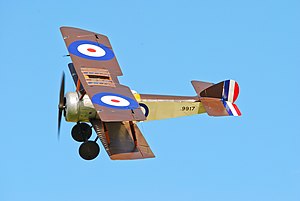Sopwith Pup
| Sopwith Pup | |
|---|---|
 |
|
| Sopwith Pup of the Shuttleworth Collection, 2013 | |
| Role | Biplane fighter |
| Manufacturer | Sopwith Aviation Company |
| Designer | Herbert Smith |
| First flight | 9 February 1916 |
| Introduction | October 1916 |
| Primary users |
Royal Flying Corps Royal Air Force Royal Naval Air Service |
| Produced | 1916-1918 |
| Number built | 1,770 |
| Variants | Beardmore W.B.III |
The Sopwith Pup was a British single-seater biplane fighter aircraft built by the Sopwith Aviation Company. It entered service with the Royal Flying Corps and the Royal Naval Air Service in the autumn of 1916. With pleasant flying characteristics and good manoeuvrability, the aircraft proved very successful. The Pup was eventually outclassed by newer German fighters, but it was not completely replaced on the Western Front until the end of 1917. Remaining Pups were relegated to Home Defence and training units. The Pup's docile flying characteristics also made it ideal for use in aircraft carrier deck landing and takeoff experiments.
In 1915, Sopwith produced a personal aircraft for the company's test pilot Harry Hawker, a single-seat, tractor biplane powered by a 50 hp Gnome rotary engine. This became known as Hawker's Runabout; another four similar aircraft have been tentatively identified as Sopwith Sparrows. Sopwith next developed a larger fighter that was heavily influenced by this design, though more powerful and controlled laterally with ailerons rather than by wing warping.
The resulting aircraft was a single-bay, single-seat biplane with a fabric-covered, wooden framework and staggered, equal-span wings. The cross-axle type main landing gear was supported by V-struts attached to the lower fuselage longerons. The prototype and most production Pups were powered by the 80 hp (60 kW) Le Rhône 9C rotary engine. Armament was a single 0.303 inch (7.7 mm) Vickers machine gun synchronized with the Sopwith-Kauper synchronizer.
...
Wikipedia
